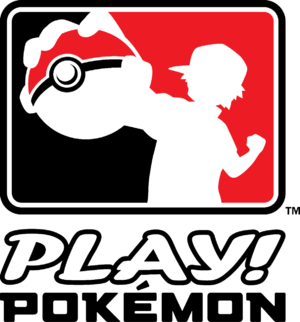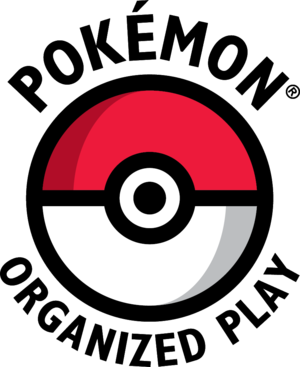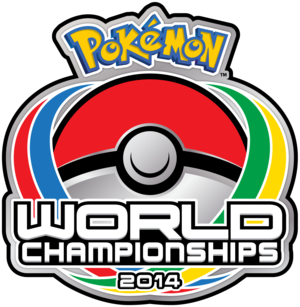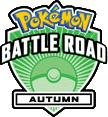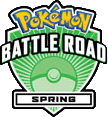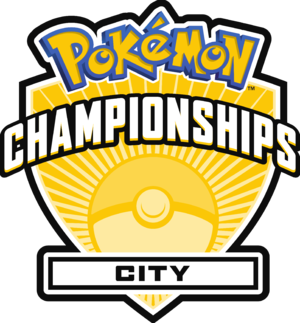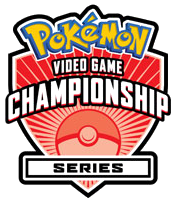Play! Pokémon
Play! Pokémon (formerly known as Pokémon Organized Play and often abbreviated as POP) is an official gathering of players of the Pokémon Trading Card Game and the Pokémon video games (often referred to as just Pokémon games) to play, trade, and just generally have fun and learn about the games. Play! Pokémon formerly oversaw activity within the Pokémon Trading Figure Game, which is no longer active, and have also included Pokkén Tournament in events since 2016.
The division was formed by The Pokémon Company International (née Pokémon USA) in 2003 after Wizards of the Coast lost their Pokémon Trading Card Game (abbreviated as TCG) license. With their stewardship, PUSA created new league, tournament, and prize systems, as well as an improved Professor Program. In 2010, the name changed from Pokémon Organized Play to its current title, Play! Pokémon.
Registration
Players playing the Pokémon Trading Card Game or Pokémon video games in organized play events or competitions are assigned a player ID. Event organizers upload player event information that may then be viewed on the Pokémon.com website by players if players also create a Pokémon Trainer Club account, including a player's Rankings, Premier Ratings, Tournaments (for Tournament Organizers only), or Leagues (for League Leaders only). After setting up a Pokémon Trainer Club account and linking that account to the player's ID, organized play information is accessed by going to "My Profile" under the Pokémon.com Pokémon Trainer Club section of the website and selecting "Play! Pokémon Settings" and then "My Play! Pokémon".
The player Pokémon Trainer Club account is also used to adjust general website settings, many Pokémon Trading Card Game Online settings, and may be used by parents to setup and control sub-accounts for their children.
Age divisions
So that younger, less experienced players are not disadvantaged by playing older, more experienced players, sanctioned Pokémon tournaments separate players into age divisions. These were defined by a specific age up until the 2006-2007 season, consisting of Ten and Under (10-), Eleven to Fourteen (11-14), and Fifteen and Over (15+). Beginning with the 2006-2007 season, the system was revised to be based on year of birth, to avoid the issues of a player shifting divisions in the middle of a tournament season.
Originally the Video Game Championship series used only two age divisions, but as of 2012 both the Trading Card Game and Video Game series have been unified to use the same age division structure.
As of July 5, 2020, the three age divisions are defined as follows:
- Junior Division: Born in 2009 or later
- Senior Division: Born in 2005, 2006, 2007, or 2008
- Masters Division: Born in 2004 or earlier
These age divisions apply for the 2019-2020 and 2020-2021 seasons, due to the cancellation of the 2019-2020 season, and the subsequent decision to allow accumulation of championship points across both seasons.
These divisions are officially adjusted when the new tournament season begins, around mid-July each year, sometime between the conclusion of National Championships worldwide and the start of the Pokémon World Championships. However, the World Championships are considered part of the previous tournament season and use its age division years.
Pokémon Leagues
- Main article: Pokémon League (TCG)
Pokémon Leagues provide a nearby place for players to get together with other fans of the Pokémon Trading Card Game and Pokémon games and have fun. They are often held in public locations, such as stores, community centers and libraries. Leagues are often the perfect venues for players starting out to learn about the TCG or video games and to hone their skills to compete in tournaments.
Leagues often focus on a theme related to the current video game every year, and break the cycle down into seven or eight seasons lasting around six weeks, each season representing a part of the theme (e.g. a specific Gym if the theme is based around Gyms featured in a Pokémon game). The theme often correlates with the current main series Pokémon games.
List of themes featured in Pokémon TCG Leagues
- 2003-04: Hoenn League
- 2004-05: Sevii Islands League
- 2005-06: Battle Frontier League
- 2006-07: Kanto League
- 2007-08: Sinnoh League
- 2008-09: Energy League
- 2009-10: Trainer League
- 2010-11: Pokéathlon League
During Wizards' tenure, players received points based on actions at every League session, and these points were recorded in League books. Points were awarded for actions such as challenging a player, winning/losing a battle, trading cards, meeting new individuals and promoting good sportsmanship.
Unlike Wizards, Play! Pokémon utilized a hybrid League system during the 2003-2004 season, where players could earn points by playing both the video games and the Trading Card Game. The idea was scrapped for the next cycle, though it since has made a comeback.
Typical prizes: When a player reaches the Poké Ball symbol or the badge symbol on their Score Card, they receive (a) promotional foil card(s). Once an entire side is filled, the player will receive a promotional Nintendo DS Lite/DSi skin. Some Leagues have a different system of handing these items out.
Player Rewards Program
This allows players who compete in Leagues, Tournaments and Premier Events to earn rewards for their efforts. Attending one of these will earn players 1 "credit". Each credit is a step toward a Rewards "Tier." At the end of each quarter, Play! Pokémon distributes the Player Rewards to those that have earned them through the mail. At one time, player who played in 3–5 events qualified for Tier One and earn 5 POP booster packs; 6–10 events qualified for Tier Two, earning 10 packs, and 11 events or more qualify for Tier Three and earned 15 packs. Thus, players could earn up to 15 POP Booster packs each quarter (three months).
POP packs
POP packs were special Pokémon TCG Booster packs that only contained two cards, as opposed to the current number of ten (at the time, nine). Introduced in September 2004, the POP sets were released roughly once every six months until September 2009. There were nine POP sets in total: Series 1, Series 2, Series 3, Series 4, Series 5, Series 6, Series 7, Series 8, and Series 9. They were created to bring useful cards that had been rotated out of play back into the game, as well as exclusive cards. With an increasing number of alternate-art Promo cards in Japan, the latest POP sets also served as a vehicle to bring them to the West. The usefulness of these latest POP sets had been a subject of debate within the Pokémon community; collectors praising PUSA for releasing these cards in English, while they faced scrutiny by players, as many cards were the same as those in then current Modified format.
POP packs were typically only be found by participating in Pokémon Organized Play events, but after leagues no longer distribute them, they were occasionally included in Value Packs, etc. sold in stores.
Player of the Year
Beginning with the 2011-2012 season, the TCG player in each age division who attained the most Play! Points during the season was awarded the title of Player of the Year, and rewarded with two boxes of each set released during the next year. Award winners were:
| Season | Junior | Senior | Master |
|---|---|---|---|
| 2011-12 | Cory Connor | Laurens van Brecht | Bruce Long |
| 2012-13 | Sydney M. | Emily Grieve | Gawein Wagner |
Local Tournaments
Local Tournaments are meant for both fun and practice. They are usually held once a week in a gaming store or other large hall such as a church by a local League Leader or Tournament Organizer. Prizes vary depending on the competitors. They are often free to enter, but organizers may charge a reasonable entry fee.
Play! Pokémon sanctioned tournaments are either single elimination, Swiss, or Swiss followed by single elimination rounds. Events in which attendance does not reach six players in every age division use 'Age Modified Swiss', (a variation of Swiss invented by Play! Pokémon) in which age divisions are mixed together and a player's age division takes priority over the player's record when the organizer pairs players.
After sanctioned tournaments are completed, the Tournament Organizer uploads the results of each match to The Pokémon Company International (abbreviated to TPCi) via Play! Pokémon. The results of each match are used to calculate a player's Premier Rating. Play! Pokémon Ratings are based on the Elo rating system.
Typical prizes
In early seasons, players could earn Promotional cards by participating in league sessions.
Prerelease Tournaments
Prerelease Tournaments are events in which players get the opportunity to play with cards from an Expansion that will be released in stores prior to the event. They are typically held on the two weekends before the set release (although a third weekend is added to the schedule if the Prerelease clashes with a major Play! Pokémon event, such as the World Championships, traditionally held in August). The fee is a minimum of $25 and each player gets four Booster packs, a 22-cards pack, and a foil black-star promo. Players may build a 40-card deck using the cards opened out of the given packs (not including basic Energy cards, which are provided at the event). If the player vouches to participate in this event, they receive additional booster packs at the end of the event.
TCG Premier Events
Premier Events are tournaments held throughout the year, offering opportunities to earn invitations to the World Championships held each August. Invitations to the World Championships could be earned, in season, by a player's Premier Ratings from 2003-2010. Each player's Premier Rating would go up and down as wins and losses were accumulated, calculated by a factor called a K-Value. In 2011, the system changed to allow only the top players in each regional zone to be invited based on Championship Points accumulated throughout the 2011-2012 season.
League Challenges
- Main article: League Challenge (TCG)
League challenges are the smallest level of currently active Pokémon TCG Premier Events. These are run by local leagues, and are intended as an entry-level event for new players who attend the local league. These events typically attract roughly 8 to 30 players, and run Swiss format with no top cut. These tournaments offer up to 15 Championship Points, as well as unique Promotional Cards for the top finishers.
League Cups
- Main article: League Cup (TCG)
Leagues Cups are the second smallest level of currently active Pokémon TCG Premier Events. These are also held by local leagues, however they are only available to leagues with a trusted record of successful turnout at events. These events are considered more prestigious than League Challenges, and will often attract a larger number of players to attend. These tournaments offer up to 50 Championship points, as well as unique Promotional cards and Play Mats for the top finishers.
Regional Championships
First introduced in 2005, this event divides countries into large regions and pits players against each other in order to become the Regional champion. Regional Championships are held around the year. These tournaments offer up to 200 Championship Points. In some countries, Regional Championships are replaced by Special Championships, which give the same Championship Point yield but no prize money.
Typical prize structure
| Place | Prize |
|---|---|
| 1st |
|
| 2nd |
|
| 3rd-4th |
|
| 5th-8th |
|
| 9th-16th |
|
| 17th-32nd |
|
| 33rd-64th |
|
All competitors receive a stamped promotional card.
International Championships
International Championships are the highest level of Premier event, aside from the World Championships. Only four of these events are held per year, in North America, Europe, Latin America, and Oceania. These events offer up to 500 Championship Points and a large prize pool. All competitors also receive an entry kit containing merchandise such as promotional cards, play mats, pin badges, deck boxes and card sleeves. These events always support both TCG and VGC, and often also comprise Pokkén Tournament events.
Typical prize structure
| Place | Prize |
|---|---|
| 1st |
|
| 2nd |
|
| 3rd-4th |
|
| 5th-8th |
|
| 9th-16th |
|
| 17th-32nd |
|
| 33rd-64th |
|
| 65th-128th |
|
| 129th-256th |
|
| 257th-512th |
|
World Championships
- Main article: World Championships
The season comes to a climax at the World Championships held in August. Only players who receive invitations via their National Championships, Premier Rating, or performance at the previous World Championships are permitted to play in this event. The event hosts top players from around the world competing for the title of Pokémon World Champion. Championship Points earned at the World Championships will be used in the next year's totals.
Qualifying Requirements
The Pokémon World Championships are an invite-only event, and players must earn an invitation by earning enough Championship Points throughout the season, or by placing highly within the region. For the 2019 season, players can earn entry for the World Championships, as well as a travel award and a bye into the second day of the tournament, by placing within the top 16 players in US & Canada, the top 22 players in Europe, the top 8 players in Latin America, or the top 8 players in Oceania. Each of these is based on a player's ranking within their region, and within their age division. Additional qualifying methods are available in other regions such as Japan. Qualification and entry into the World Championships, without travel awards or byes, are also earned by collecting a given amount of Championship points throughout the season.
| Rating Zone | Junior | Senior | Master |
|---|---|---|---|
| US & Canada | 350 CP | 400 CP | 550 CP |
| Europe | 250 CP | 250 CP | 350 CP |
| Latin America | 250 CP | 250 CP | 250 CP |
| Oceania | 250 CP | 250 CP | 250 CP |
| South Africa | 150 CP | 150 CP | 250 CP |
Typical prize structure
| Place | Prize |
|---|---|
| 1st |
|
| 2nd |
|
| 3rd |
|
| 4th |
|
| 5th-8th |
|
| 9th-32nd |
|
In addition, all qualified players receive a welcome pack of exclusive World Championships-themed merchandise, usually containing Promo Cards, Plushes, deck boxes and T-Shirts.
Retired TCG Premier Events
Gym and Stadium Challenges
In these events, players from many areas came together to play for a World Championships invitation. Stadium Challenges were phased out in the 2005-2006 season, and Gym Challenges were ended beginning in the 2006-2007 season in favor of Battle Road Tournaments, similar to those held in Japan.
Typical prizes included an invitation to play in the World Championships of that year, a travel award and hotel stay for the tournament (for those who ranked high up), a combination of Booster packs, a stamped promotional card and commemorative pin.
Battle Road Tournaments
Held in the Autumn and the Spring, the Battle Road tournaments were entry level tournaments which give players the opportunity to earn up to 15 Championship Points, and have a Best Finish Limit of 6 (Autumn and Spring combined). Battle Road Autumn tournaments were held between September and October, while the Spring tournaments were held between May and June. The Battle Road tournament level has been retired.
Typical prize structure
| Place | Prize |
|---|---|
| 1st |
|
| 2nd |
|
| 3rd |
|
| 4th |
|
| 5th-8th |
|
| 9th-12th |
|
| 13th-16th |
|
City Championships
The third event in the Championship Series, held between November and January, were the City Championships. City Championships allow players to earn up to 50 Championship Points, and have a Best Finish Limit of 4. Though commonly held on weekends, some major cities are known to hold tournaments daily in large, adjacent suburbs for a period of four to nine days, with one or two days of rest within. The City Championships tournament level has now been retired.
Typical prize structure
| Place | Prize |
|---|---|
| 1st |
|
| 2nd |
|
| 3rd-4th |
|
| 5th-8th |
|
| 9th-12th |
|
| 13th-16th |
|
| 17th-32nd |
|
All competitors receive a stamped promotional card.
State/Province/Territory Championships
Previously known as 'State Championships' before the 2006-2007 season, this event, held on one of three weekends in March, brings together players from States, Provinces, and Territories, as well as neighboring areas, to determine the State, Provincial, or Territorial Champion. Players can earn up to 100 Championship Points, and these events come together with Regional Championships to form a Best Finish Limit of 4. This level of tournament has now been combined with Regional Championships.
Typical prize structure
| Place | Prize |
|---|---|
| 1st |
|
| 2nd |
|
| 3rd-4th |
|
| 5th-8th |
|
| 9th-12th |
|
| 13th-16th |
|
| 17th-32nd |
|
| 33rd-64th |
|
All competitors receive a stamped promotional card.
National Championships
The National Championships are the penultimate event of the Championship Series. Held between April and June in countries across the globe, it gives players in good standing to compete to become National Champion and give their Championship Points a boost, potentially winning an invitation to Worlds. As of 2017, National Championships have been retired and replaced with International Championships.
Typical prize structure
| Place | Prize |
|---|---|
| 1st |
|
| 2nd |
|
| 3rd-4th |
|
| 5th-8th |
|
| 9th-12th |
|
| 13th-16th |
|
| 17th-32nd |
|
| 33rd-64th |
|
| 65th-128th |
|
All competitors receive a stamped promotional card.
Last Chance Qualifier
The Last Chance qualifier, referred to casually as "the grinder," is an event held on-site on the first day of the World Championships. Typically, it consists of multi-round single-elimination, best of three tournament. The number of players who receive Worlds invites from the Last Chance Qualifier is dependent on how many Worlds spots have been claimed through Championship Points and other tournaments. As of Worlds 2015, TCG no longer runs a Last Chance Qualifier event, but instead feature other side events worth Championship Points in the following season.
Video Game Championships
The Pokémon video games have their own set of tournaments which usually parallel with the Trading Card Game. One of the first instances of a major video game tournament was the Pokémon 10th Anniversary Journey Across America, where tournaments were held as part of the tour. The first Video Game National Championships was held at the Party of the Decade on August 8, 2006 at Bryant Park in New York City. In 2008, at the TCG World Championships, a special Video Game Showdown was held. Players were separated into Junior and Senior Divisions. This tournament would evolve into the first formal World Championships for the Pokémon video games in 2009.
Premier Challenges
Premier Challenges are the smallest level of VGC Premier Event, and can be seen as a parallel to League Challenges. These are organized by local Tournament Organizers and intended as an entry level for new players. These events offer up to 30 Championship Points.
Midseason Showdowns
Midseason Showdowns, commonly abbreviated to MSS, are the second smallest level of VGC Premier Event. These can be seen as a parallel to League Cups. Like Premier Challenges, these are organized by local Tournament Organizers, but often attract more players due to the higher point yield. These events offer up to 50 Championship Points.
Regional Championships
Regional Championships are held throughout the year, usually alongside the TCG. These events offer up to 200 Championship Points. In some countries, Regional Championships are replaced by Special Championships, which give the same Championship Point yield but no prize money.
Typical prize structure
| Place | Prize |
|---|---|
| 1st |
|
| 2nd |
|
| 3rd-4th |
|
| 5th-8th |
|
| 9th-16th |
|
| 17th-32nd |
|
| 33rd-64th |
|
All competitors receive a stamped promotional card.
International Championships
International Championships are the highest level of Premier event, aside from the World Championships. Only four of these events are held per year, in North America, Europe, Latin America, and Oceania. These events offer up to 500 Championship Points and a large prize pool. All competitors also receive an entry kit containing merchandise such as promotional cards, play mats, pin badges, deck boxes and card sleeves. These events always support both TCG and VGC, and often also comprise Pokkén Tournament events. Typically, these events are held over three days for Masters, with Swiss rounds occurring on the first and second day, and a single-elimination top cut occurring on the third day. For Juniors and Seniors, these are typically held over two days. Travel awards to compete in Pokémon International Championships are given to 4 players per age division in each rating zone, based on Championship Points earned during a period earlier in the season.
Typical prize structure
| Place | Prize |
|---|---|
| 1st |
|
| 2nd |
|
| 3rd-4th |
|
| 5th-8th |
|
| 9th-16th |
|
| 17th-32nd |
|
| 33rd-64th |
|
| 65th-128th |
|
| 129th-256th |
|
| 257th-512th |
|
World Championship
- Main article: World Championships#Video games
The Pokémon VGC World Championships are a three-day event, with Swiss rounds taking place on days 1 and 2, with the single-elimination top cut and finals taking part on day 3. Players who perform highly within their rating region can earn Byes to automatically advance to the second day of the event. 2009 in San Diego, California.
Qualifying Requirements
The Pokémon World Championships are an invite-only event, and players must earn an invitation by earning enough Championship Points throughout the season, or by placing highly within the region. For the 2019 season, players can earn entry for the World Championships, as well as a travel award and a bye into the second day of the tournament, by placing within the top 8 players in US & Canada, the top 16 players in Europe, the top 8 players in Latin America, or the top 8 players in Oceania. Each of these is based on a player's ranking within their region, and within their age division Additional qualifying methods are available in other regions such as Japan. Qualification and entry into the World Championships, without travel awards or byes, are also earned by collecting a given amount of Championship points throughout the season.
| Rating Zone | Junior | Senior | Master |
|---|---|---|---|
| US & Canada | 200 CP | 250 CP | 400 CP |
| Europe | 200 CP | 250 CP | 300 CP |
| Latin America | 200 CP | 250 CP | 400 CP |
| Oceania | 200 CP | 200 CP | 300 CP |
| South Africa | 100 CP | 150 CP | 250 CP |
Typical prize structure
The following prize structure was accurate as of the 2018 season.
| Place | Prize |
|---|---|
| 1st |
|
| 2nd |
|
| 3rd - 4th |
|
| 5th-8th |
|
| 9th-16th |
|
In addition, all qualified players receive a welcome pack of exclusive World Championships-themed merchandise, usually containing Promo Cards, Plushes, deck boxes and T-Shirts.
Retired VG Premier Events
National Championship
National Championships were the penultimate event in the VG Championship Series. They offered invitations to the World Championships for the high finishers in the tournament. Since 2017, these have been retired and replaced with International Championships.
Typical prize structure
| Place | Prize |
|---|---|
| 1st |
|
| 2nd |
|
| 3rd-4th |
|
| 5th-8th |
|
| 9th-16th |
|
| 17th-32nd |
|
| 33rd-64th |
|
| 65th-128th |
|
All competitors receive a stamped promotional card.
Pokkén Tournament
Since 2016, Play! Pokémon have also run a series of events on Pokkén Tournament for the Nintendo Wii U and Pokkén Tournament DX for the Nintendo Switch. Unlike TCG and VGC, these events are always held in a Double Elimination tournament format. Qualifying events are usually held as part of a Regional Championship, National Championship, International Championship, or as a Last Chance Qualifier at the World Championships. Top finishers at these events qualify directly for the Pokkén Tournament event at the Pokémon World Championships. At these events, all characters including unlockable characters and DLC characters are permitted, and games are held using the Event Mode, which forces a LAN connection giving each player a full screen to play on. Only the Hori Pokkén Controller is permitted, and players are encouraged to bring their own controllers.
- During the 2016 and 2017 seasons, events were held on Pokkén Tournament for the Nintendo Wii U
- During the 2018 season, events were held on Pokkén Tournament DX for the Nintendo Switch using the Basic Battle mode
- During the 2019 season, events were held on Pokkén Tournament DX for the Nintendo Switch using the Team Battle mode
External links

|
This article is part of both Project Games and Project TCG, Bulbapedia projects that, together, aim to write comprehensive articles on the Pokémon Games and TCG, respectively. | 
|

